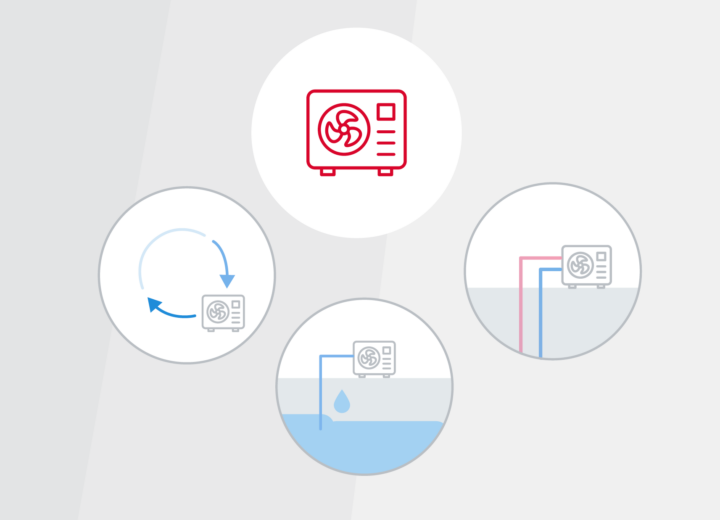Underfloor heating and cooling or surface heating and cooling (SHC) is compatible with all heating sources. But when combined with heat pumps, SHC can be used to both heat in winter and cool in summer. Here’s everything you need to know about this reversible system.
Cooling system: combining heat pumps and SHC
Heat pump reversibility
Heat pumps – whether they collect energy from the air, water, or ground – can be reversible. Reversible heat pumps are environmentally friendly because they don’t release F-gas or Co2.
If you already have an air-to-water heat pump, you can simply use an add-on kit to cool your home in the warmer months.
Underfloor heating system
There is no air conditioning with surface heating and cooling, but the cooling effect created is enough to keep you comfortable in the middle of summer. Cold water circulates inside the tube, lowering the temperature by 3°. This means that no heat is stored in the building.
This system can be combined with other cooling solutions such as vegetation, building orientation, and not installing bay windows.

| Hidden benefits 💡 |
Some hidden benefits to consider:
|
Why is it so cheap to use?
1 system instead of 2
This solution means you only need one product to heat and cool a building. Previously, you needed a boiler and an air conditioner to maintain the same comfort in winter and summer.
The heat pump and underfloor heating (SHC) combination is cheaper because there are fewer products to buy, store and operate. And since you only have one system to manage, it requires less maintenance.
Less energy-intensive
Free calories of energy can be drawn from the ground with this type of system.
“Reversible air conditioners consume 25-40% less electricity than standard electric heaters.”1
The only energy used is to power the compressor, which extracts the calories from the outside air.
An air-to-water heat pump can divide the source energy consumption by 2. That’s because the energy is taken directly from the environment.2
“With the help of a heat pump, we can extract the heat from the property and cool without using a lot of energy. The cold drawn from the ground can then be returned to a living space: producing cool air without using energy!”
Sophie Keloganian
Technical Training Manager – Aalberts hfc
Another huge advantage of this system is that it’s more environmentally friendly. The energy saving leads to less pollution and less consumption, and also helps you meet the requirements of the European Green Deal.
In terms of monitoring, it’s important to regulate the room temperature. ADEME recommends setting the temperature at 27°C in summer. Investing in a programmable thermostat to use with a monitoring system can be valuable. This will help you to control your consumption – with energy savings of up to 15%.3
🚨 A few factors to keep in mind
There are certain safety requirements when using a cooling system with an underfloor heating system.
Managing condensation
Using too cold water causes air humidity condensation. To avoid this, you should use a dew point monitor. This device measures the tube temperature and stops cooling if the tubes are too cold, preventing condensation from moisture in the air.
The collector should also be taken care of: a synthetic collector is recommended to avoid condensation. In the case of a metal manifold, it must be carefully insulated (with no air between the metal and the insulating material).
Adapting to your geographical area
The water temperature in systems varies depending on the geographical area. This can affect the performance of your cooling system. For example, in a very humid area near the sea, the water will be hotter than in a dry or inland area (EN 1264 standard).
These temperatures are defined using heating degree days (HDD) and cooling degree days (CDD). These measurements are calculated by area, and heating and cooling systems should be adjusted accordingly.
Combining a heat pump with underfloor heating is a great way to save energy and money. And it means you only need one system for your heating and cooling needs. In these low-temperature systems, more air is dissolved in the water. They’re also a conducive environment for sludge. Installing a sludge and air removal system will help ensure a durable network.
1 Source: Electricity consumption of reversible air conditioners
2 Source: Heat pump or electric radiators?
3 Source: ADEME, Why switch to a programmable thermostat?




